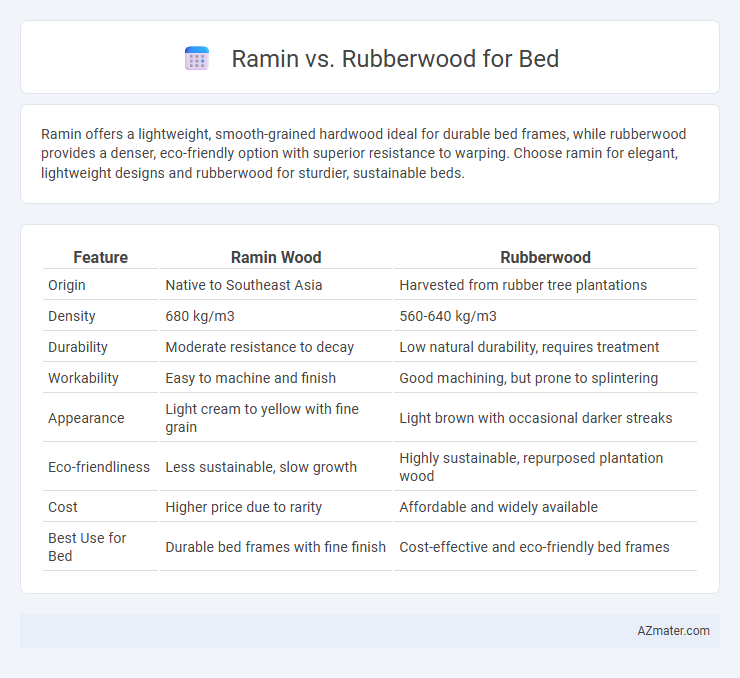Ramin offers a lightweight, smooth-grained hardwood ideal for durable bed frames, while rubberwood provides a denser, eco-friendly option with superior resistance to warping. Choose ramin for elegant, lightweight designs and rubberwood for sturdier, sustainable beds.
Table of Comparison
| Feature | Ramin Wood | Rubberwood |
|---|---|---|
| Origin | Native to Southeast Asia | Harvested from rubber tree plantations |
| Density | 680 kg/m3 | 560-640 kg/m3 |
| Durability | Moderate resistance to decay | Low natural durability, requires treatment |
| Workability | Easy to machine and finish | Good machining, but prone to splintering |
| Appearance | Light cream to yellow with fine grain | Light brown with occasional darker streaks |
| Eco-friendliness | Less sustainable, slow growth | Highly sustainable, repurposed plantation wood |
| Cost | Higher price due to rarity | Affordable and widely available |
| Best Use for Bed | Durable bed frames with fine finish | Cost-effective and eco-friendly bed frames |
Introduction: Ramin vs Rubberwood for Beds
Ramin and rubberwood are popular choices for bed frames, valued for their durability and affordability. Ramin, a tropical hardwood, offers a fine, dense grain with a pale yellow to light brown color, making it ideal for smooth finishes and intricate designs. Rubberwood, sourced from the Para rubber tree, is eco-friendly and exhibits a light blond to medium brown hue with consistent strength, commonly used in budget-conscious furniture with a natural appearance.
Origin and Source of Ramin and Rubberwood
Ramin wood originates predominantly from Southeast Asia, especially Indonesia and Malaysia, where it is harvested from tropical lowland forests. Rubberwood, also known as plantation hardwood, is sourced mainly from rubber tree plantations in countries such as Thailand, Malaysia, and Indonesia, where the trees are replanted after latex extraction. The sustainable sourcing of rubberwood from end-of-life rubber trees contrasts with ramin's extraction from natural forests, impacting their availability and environmental footprint in bed manufacturing.
Physical Characteristics and Appearance
Ramin wood features a light, creamy yellow to pale brown color with a fine and uniform texture, making it ideal for elegant bed frames requiring a smooth finish. Rubberwood, characterized by its pale yellow to light brown hue and straight grain, offers a dense and durable option with a slightly coarse texture that resists warping. Both types provide strength, but Ramin's consistent grain pattern enhances aesthetic appeal, while Rubberwood's robustness supports long-lasting furniture performance.
Durability and Strength Comparison
Ramin wood offers moderate durability and strength, making it suitable for lightweight furniture but less ideal for heavy-use beds. Rubberwood, known for its dense grain and high hardness, provides superior strength and long-lasting durability, ensuring a stable and resilient bed frame. Choosing rubberwood over Ramin results in better resistance to wear, warping, and weight-bearing capacity in bedroom furniture.
Sustainability and Environmental Impact
Rubberwood is highly sustainable due to its use of plantation trees grown primarily for latex production, which are repurposed after their latex yield declines, minimizing deforestation impact. Ramin, harvested from tropical forests, faces environmental concerns related to overharvesting and slower growth rates, leading to stricter regulations to prevent illegal logging. Choosing rubberwood for beds supports sustainable forestry practices and reduces carbon footprint, whereas ramin's environmental impact is more significant and less eco-friendly.
Cost and Market Availability
Ramin wood is generally more affordable than rubberwood due to its faster growth rate and abundant supply in Southeast Asia, making it a budget-friendly option for bed frames. Rubberwood, while slightly pricier, is widely available in global markets because it is a byproduct of the rubber industry, often sourced from plantations in countries like Malaysia, Thailand, and Indonesia. Both woods offer competitive market availability, but cost considerations usually favor ramin for cost-conscious consumers seeking durable and economical bed materials.
Workability and Finishing Qualities
Ramin wood offers excellent workability due to its fine, even texture and low density, making it easy to saw, carve, and shape for bed frames. Rubberwood is also highly workable with a straight grain and moderate hardness, but it may require pre-drilling for nailing or screwing to prevent splitting. Both woods accept stains and finishes well; however, ramin's smooth surface allows for a more uniform finish, while rubberwood's tendency to blotch may necessitate a wood conditioner for optimal results.
Maintenance and Longevity
Ramin wood requires regular sealing and polishing to maintain its smooth surface and prevent moisture damage, ensuring durability for bed frames. Rubberwood offers excellent resistance to pests and fungal attacks, minimizing maintenance needs and enhancing lifespan in bedroom furniture. Both woods provide sturdy bed foundations, but Rubberwood's natural resilience contributes to longer-lasting performance with less upkeep.
Pros and Cons of Ramin Beds
Ramin beds offer a smooth, pale finish with a fine grain that enhances bedroom aesthetics and resists warping due to their durability. This wood is lightweight and easy to work with, providing a cost-effective alternative to harder hardwoods while maintaining reasonable strength. However, Ramin wood is less resistant to moisture and insect damage compared to Rubberwood, requiring regular maintenance to prevent wear and potential structural issues over time.
Pros and Cons of Rubberwood Beds
Rubberwood beds offer high durability, eco-friendliness, and affordability, making them a popular choice for affordable yet sturdy furniture. The wood's resistance to warping and cracking ensures a long-lasting bed frame, but its susceptibility to moisture and insect damage requires proper treatment and care. While less expensive than hardwood alternatives like Ramin, rubberwood may lack the fine grain and aesthetic appeal some buyers seek in premium bed designs.

Infographic: Ramin vs Rubberwood for Bed
 azmater.com
azmater.com